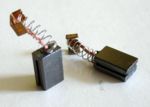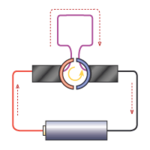- Slip ring
-
Collecteur tournant
Les collecteurs tournants ou rotatifs sont des organes permettant de créer une connexion électrique entre une partie fixe (stator) et, une partie tournante (rotor) dans le cas d'une rotation multi-tours, là où une transmission par câble serait impossible. On trouve notamment :
- le collecteur à bague rotatif, pour certaines machines électriques à courant alternatif ;
- le collecteur commutateur rotatif, pour certaines machines électriques à courant continu.
Sommaire
Collecteur à bague rotatif
En électrotechnique, un collecteur à bague rotatif (slip ring en anglais) est un organe permettant de créer une connexion électrique entre une partie fixe (stator) et une partie tournante (rotor). On trouve ce genre de collecteurs en particulier dans les alternateurs ainsi que certaines machines synchrones et asynchrones à rotor bobiné.
Fonctionnement
Le collecteur à bague rotatif consiste en un anneau conducteur de l'électricité (généralement en cuivre), fixé par une entretoise isolante sur l'axe de la machine. La connexion électrique est créée entre l'anneau et la partie fixe, le bornier, par un « balai » réalisé à base de carbone (ou une lame de métal souple dans les très petites machines). Avec deux anneaux et deux balais, il est possible de transférer l’électricité produite par les bobinages du rotor hors de la machine tournante ou, à l'inverse, d'alimenter le ou les bobinages du rotor.
Ce type de collecteur s'apparente au collecteur commutateur rotatif des moteurs à courant continu, mais à la différence de ce dernier, il ne provoque aucune coupure : il est donc plus fiable et produit moins de parasites.
Collecteur commutateur rotatif
En électrotechnique, un collecteur commutateur rotatif est un organe permettant de créer une connexion électrique entre une partie fixe (stator) et une partie tournante (rotor), avec une fonction de commutation pendant la rotation. On trouve ce genre de collecteur dans les machines à courant continu et les moteurs électriques universels.
Fonctionnement
Ce collecteur commutateur rotatif consiste en un anneau conducteur de l'électricité (généralement en cuivre), sectionné en un nombre pair de parties isolées entre elles, fixé avec une entretoise isolante sur l'axe de la machine. La connexion électrique est créée entre les parties conductrices et la partie fixée sur le stator (bornier), par une ou plusieurs paires de balais réalisés à base de carbone (ou des lames de métal souple pour les très petites machines) positionnées respectivement à 180°. On alimente en électricité le bobinage du rotor par ces contacts (fonctionnement en moteur) ou au contraire on récupère l'électricité produite par le bobinage du rotor (fonctionnement en générateur).
Fabricants
Les principaux fabricants de collecteurs tournants sont : Air Precision SAS, Label SAS, Ltn Servotechnik et Schleifring und Apparatebau GmbH (en Allemagne), Morgan-Rekofa et Moog Components Group (aux États-Unis et en Europe). Concernant les ensembles balais et porte-balais, le principal fabricant français est Carbone Lorraine. En Europe, la société belge Gerken est également très active sur ce marché.
Sources
- (en) Cet article est partiellement ou en totalité issu d’une traduction de l’article de Wikipédia en anglais intitulé « Slip ring ».
- (en) Cet article est partiellement ou en totalité issu d’une traduction de l’article de Wikipédia en anglais intitulé « Commutator (electric) ».
- Portail de l’électricité et de l’électronique
Catégories : Machine électrique | Électrotechnique
Wikimedia Foundation. 2010.


